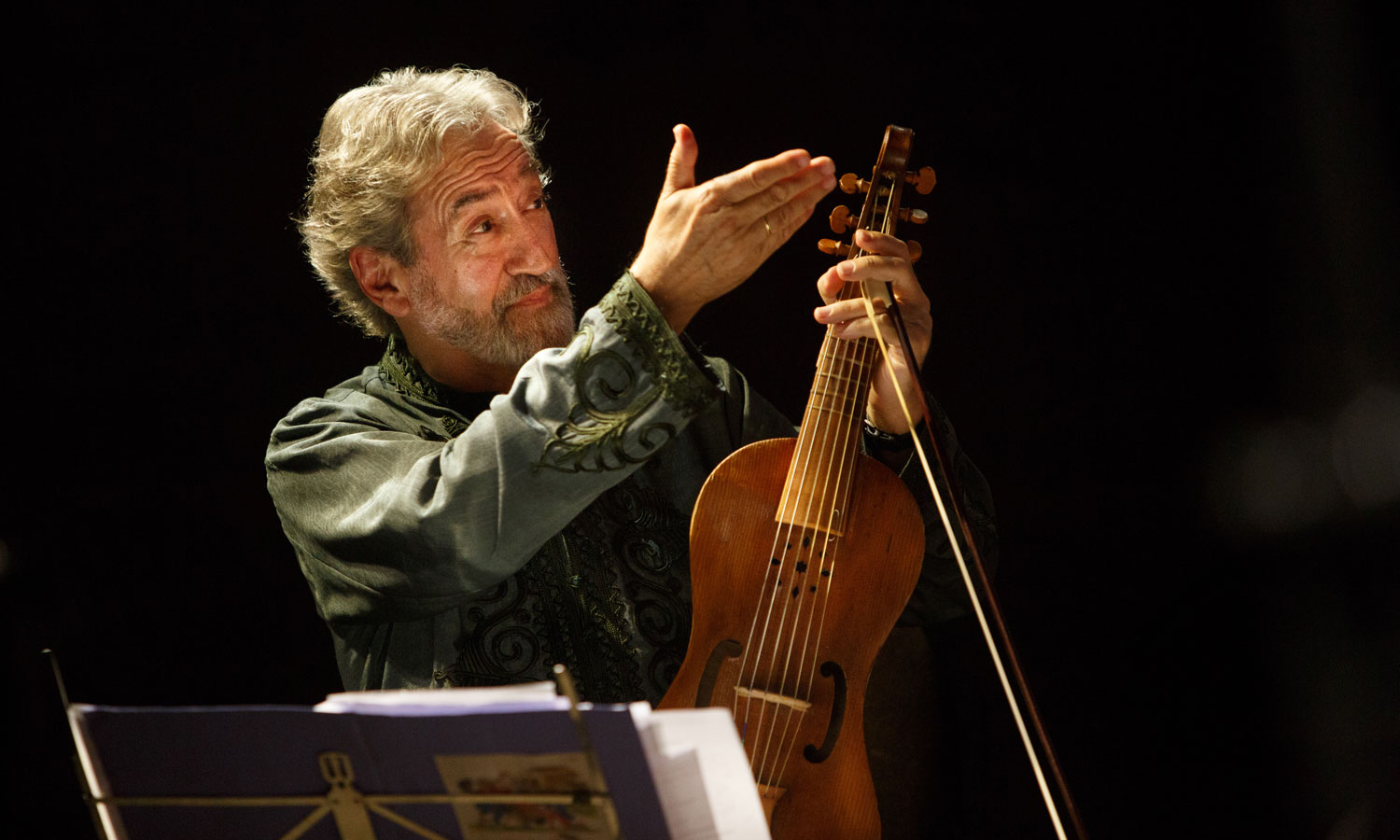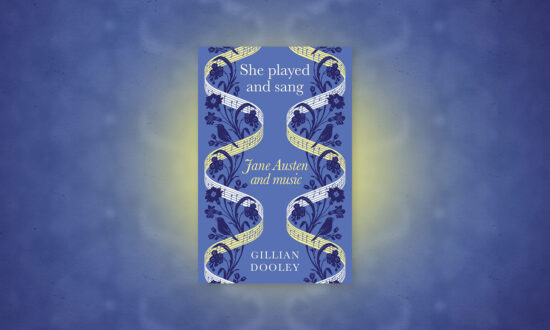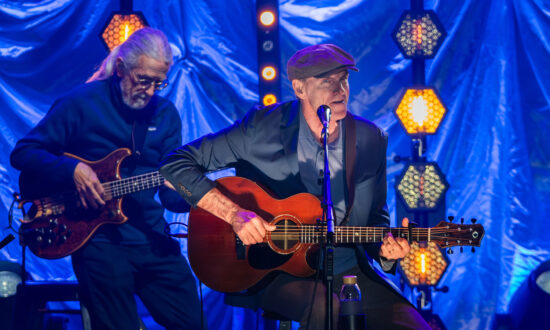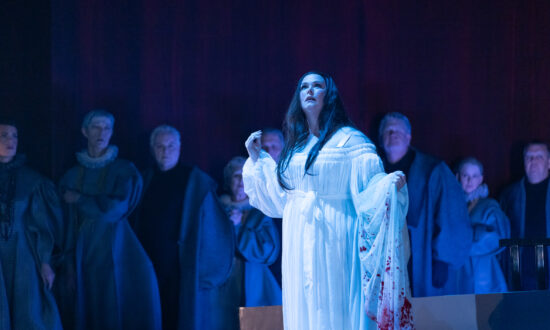Savall is now an octogenarian (and young looking at that), but it’s worth briefly recounting his background and how he’s become such a huge force in early music. As a young boy from Catalan, he started on cello before inquisitiveness led him to take up the viola da gamba while in his 20s, learning first by himself and then from Wieland Kuijken in Brussels and August Wenzinger in Basel.
Five decades later, this legendary man and his group, Hespèrion XXI, command huge cachet in the concert world.
Savall has been here before, and some will no doubt remember what happened on one exceedingly hot evening when he played in St Peter’s Cathedral at the 2013 Adelaide Festival. With a fan next to him, his music wafted off his music stand onto the floor some distance away. Unperturbed, he kept playing as if nothing happened, improvising through to the end of the piece.
Sometimes, odd incidents like this really tell you what a musician is made of.
Well, another even more alarming thing happened this time – which we might just mention to begin with, only because it told us more about Savall’s unshakeable calmness and nerves of steel.
The top D string of his treble viol snapped right at the end of one of the pieces, Alfonso Ferrabosco’s Fantasia à 6, resulting in a sudden loss of pitch accompanied by a loud bang. Now, let it be known, when this happens it presents a horror scenario. Usually the player concerned withdraws red-faced from the stage to frantically restring their instrument.
Not so Savall. With the casualness of someone rolling their own cigarette, and while still sitting in his chair, he drew out a pair of snippers from one pocket and a string packet from the other, and went about carefully restringing his instrument. It took him some minutes to thread it up, but while he did so he explained that gut strings do this sometimes due to changes in humidity. We also learned that his lovely little treble viol is a Barak Norman from 1590.
An embarrassing moment became a special moment – a time for us all to pause and admire this special group and their gorgeous instruments. The seven other members chatted pleasantly. It felt natural.
This concert, entitled Fantasies, Battles and Dances: the golden age of European consort music 1500-1750, consisted of a fabulously rich abundance of consort music from all the early music composers you’d want to hear but so rarely do: Tye, Dowland, Gibbons, Jenkins, Purcell and even Bach. It was enough pavanes, galliards and fantasias to fill an early music feast.
Other viol consort groups tend to do bitty, stop-start programs, but Hespèrion XXI’s programs are so carefully crafted that it all becomes a wonderful blur. With drum rolls and chordal improvisations from theorbo in between pieces, this program was thoroughly satisfying in its long spans.
Refined, stately pieces were mixed with fiery numbers in which the sparks flew. Savall often does this in his concerts: he spices things up no end. So we also had battle music from Pierre Attaignant, Samuel Scheidt and others.
Oh, and there was a special touch. Among Hespèrion XXI’s eight members was their talented new recruit, Cuban-born Lixsania Fernández, on tenor viol. But the discovery was to see that she also dances – extremely well. Sporting a purple hairdo and gauzy dress, she placed her instrument on the floor and came out to the front to gracefully glide, turn and swing to the music. Capturing perfectly the idea of courtly dance, it showed how music and dance really are one and the same language.
These days, David Mayoral takes the place of Pedro Estevan on percussion in Hespèrion XXI, with comparable authority. One relished all that subtle weight, air and invention he adds to drum and tambourine.
Savall and his group’s style is so fascinating. One can try to dissect it, but doing so is always hard because much of what they do is not immediately noticeable: a lot of their artistry lies under the radar of conscious observation.
But let’s have a go. On treble viol, his playing is understated but has an athletic prowess as well. The way he treats melody is varied and pliant. Most distinctive of all, though, is how he adds a rich assortment of ornaments, consisting of flutters, mordants, trills, runs and divisions. Yes, and oodles of vibrato (some died-in-the-wall early music purists still outlaw this). All this comprises his style, much of it gleaned from the viola da gamba’s first great master, Diego Ortiz from the 16th century. Rediscovering his classic treatise, Trattado de glosas (1553), indeed sparked Savall’s interest in improvisation.
As a consort, Hespèrion XXI sounds airy, floaty and super smooth. The slower pieces are lush and elegant. In dance pieces, one notices how they push out rhythms with great energy while never sounding in the least rough. Savall’s consortiers all partake in the same style that he has made so distinctively his own, although in slightly different ways.
One could particularly admire the other treble viol player, Philippe Pierlot, who used lots more bow on his mellower, medieval-shaped instrument. Different in sound but so wonderfully complementary.
Meanwhile on the violone, Xavier Puertas often just added whispers of sound, reinforcing the bass viol but everything down an octave for depth.

Get InReview in your inbox – free each Saturday. Local arts and culture – covered.
Thanks for signing up to the InReview newsletter.
Pieces that were especially enjoyable were Christopher Tye’s extremely busy In Nomine XII, “Crye”, and two Contrapunti from Bach’s The Art of Fugue. These were married so well with Purcell’s preceding Fantasia upon one note that they might as well have been from the same composer in their angular lines and rich harmonies.
Savall looks happy these days. Following the loss of his first wife, the very fine singer Montserrat Figueras, he is married once again, to the Spanish philosopher Maria Bartels.
This visit to Australia was only brief, but it was radiant and similarly unforgettable. Hespèrion XXI’s music-making is always fresh and inspired, and this time it seemed especially so. They perform at the pinnacle of achievement and are rightfully much loved. Three encores said that loud and clear.
Jordi Savall with Hespèrion XXI presented Fantasies, Battles and Dances at UKARIA Cultural Centre on February 26.
Support local arts journalism
Your support will help us continue the important work of InReview in publishing free professional journalism that celebrates, interrogates and amplifies arts and culture in South Australia.
Donate Here




